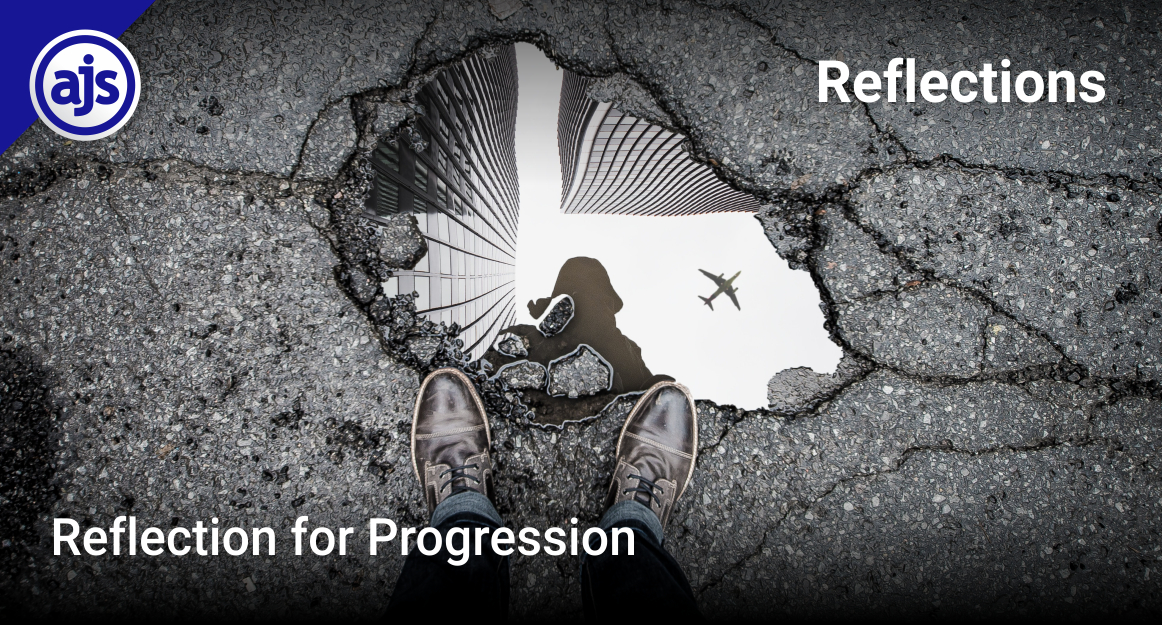
REFLECTIONS: Reflection for progression
There is no doubt in our minds that what happens in the world around us will have a profound affect on how we live, how we work and how business will either boom or fail.
We are – after all – a product of what happens around us and as such, the events that occur within our borders (and those beyond it too), will have a ripple effect on economies around the globe. Nothing happens in isolation.
As the late Madeleine L’Engle, acclaimed author of a Wrinkle in Time said –
“Nothing happens in isolation . . . Everything in the universe is interrelated.”
And this is quite evident where world events and business is concerned.
They are all interrelated.
While 2022 is not yet over, we are certainly heading for the end of it. By doing so, reflecting on what 2022 has presented to us and how it has affected business becomes paramount.
Because as we have said in previous articles, reflecting on what has happened helps us properly prepare for what is to come. And no more so when planning how to best run your practice in a new year.
What will it hold? What difficulties will it uncover and how will we all be challenged? The only way to answer any of these questions (with any certainty anyway), is by looking back on what has already happened.
Reflection is crucial for progression!
World events impacting business
It’s no secret that worldwide economies have been affected by current events. While there have been a few that have rocked our news screens, there are some major ones that have seriously impacted countries worldwide –
Covid 19
We hate rehashing the same event continuously but there is no denying that it had a tremendous impact on business. The COVID 19 pandemic plunged the global economy into recession with the world bank forecasting in 2020 that the global economy would shrink by 5.2%, which “would represent the deepest recession since the Second World War, with the largest fraction of economies experiencing declines in per capita output since 1870” (World Bank). As 2021 rolled around the World Bank again set out some alarming statistics related to companies around the world –
Ø One-fourth of companies saw their sales fall 50%
Ø On average sales dropped by 27%
Ø 65% of businesses adjusted payroll by reducing hours, wages or granting leave.
Supply chain issues started from pandemic-related restrictions, which placed factories and warehouses around the world in a position where they could only operate at an extremely limited capacity – if at all. And because of an inability to produce, there was a limited availability of goods, leading to an inevitable increase in price.
As 2022 rolled around the World Bank had reported that while there had been a strong rebound to world economies towards the end of 2021, we had once again entered a pronounced slowdown at the beginning of 2022 amid a rise in inflation, debt, and income inequality (World Bank).
But as so often happens and in a weird twist of fate, the global recession caused by Covid 19 (sort of) prepared us all for some other rude awakenings – in the form of the War in Ukraine and the ever-looming Energy Crisis.
The War in Ukraine
On 25 February 2022, Russia invade Ukrainian in a major escalation of the Russo-Ukrainian War, which began in 2014 following Russia’s annexation of Crimea (Global Conflict Tracker).
The impact of the War in Ukraine has had a multipronged affect on the global economy in ways that businesses around the world could not have imagined. There are a lot of references here, most notably Forbes, the International Rescue Committee, the BBC, News24, the International Energy Agency and CNN Business (which we encourage you to read), the following impacts on business have been felt most deeply (worldwide) –
Supply chain issues across Europe
E-commerce companies based in China, The Netherlands, Germany, and Italy have been left in a tizz over how to best manage their supply chain risk. Since the start of the war in Ukraine, the extensive and debilitating supply chain disruption intensified, particularly for producers who buy components and materials from Europe. The impact has been felt by over 300,000 companies out of the US and Europe, due to their supply chain dependencies on Russia and Ukraine. Russia is a significant exporter of a wide range of materials, which include wood, iron, copper, precious metals, gems, pearls, fuel, oil, wheat, cereals, and more. Ukraine also has abundant reserves of coal, iron ore, natural gas, manganese, salt, oil, graphite, sulfur, kaolin, titanium, nickel, magnesium, timber, and mercury. But it’s unlikely that international investors will fund development of any new business ventures within the region until there is sustained peace – which makes perfect sense.
Increase in food and fuel prices
The ongoing conflict in Ukraine is driving up the cost of fuel, which in turn increases the cost to transport food to markets. Such increases are passed on to consumers, who may already have difficulty buying enough food for their families. In March 2022, the price of fuel in The Netherlands had risen to about $9.43 per gallon. Gas prices in the U.S also increased to the point of breaking national records, at approximately $4.17 per gallon. And this increase in gas price has – obviously – led to an increase in the shipping costs. And this has necessitated the need for many companies around the globe to switch to the faster option of air freight for shipping – more expensive upfront but helps mitigate costs overall. But this will, of course, once again end with the consumer who will have to shell out more cash for the same goods.
Global grain exports
Blockades of Ukrainian grain exports have worsened hunger in some of the world’s most vulnerable regions. The conflict has disrupted crop production, which means countries heavily reliant on grain imports from Ukraine have been severely impacted. Among them are countries across East Africa, including Somalia, Ethiopia, and Kenya, which source 90% of their imported wheat from Russia and Ukraine. These three countries are already facing the worst drought seen in decades.
Step in – the Grain Deal. Another issue amid the War in Ukraine that has been causing a heap of uncertainty is the Russian “Grain Deal”. There has been a lot of back and forth between Russia and Ukraine in a bid for Ukraine to start once again exporting grain to the rest of the world via the Black Sea, something which has become increasingly crucial. Russia and Ukraine have been in discussions for some time now around the so-called “grain deal” but (in a not extremely surprising move), Russia pulled out of this agreement on Saturday 29 October after accusing the Ukraine of using a safety corridor to attack its fleet – “Moscow had pulled out at the weekend, saying it could not guarantee the safety of civilian ships crossing the Black Sea because of a drone attack on its fleet there”. Despite Russia seemingly pulling out of the agreement, 12 ships carrying 354,500 tons of food (a record volume) sailed from Ukraine on Monday 31 October. But in what is a surprising move and following a phone call from Turkish President Tayyip Erdogan on Tuesday, Russia has once again u-turned on their withdrawal from the grain deal. The Russian ministry had credited its “about-turn” to the involvement of the United Nations and Turkey, making it possible to “obtain written guarantees from Ukraine that it would not use the humanitarian corridor and Ukrainian ports to conduct military operations against Russia”. A “saving face” move by the Kremlin.
The energy crisis
At the end of July this year, Russia reduced gas flows to Europe via the Nord Stream 1 pipeline to 20% capacity. Now, Russia has largely cut off gas supplies to Europe in retaliation against sanctions imposed on it following its invasion of Ukraine. This has deepened market tensions and uncertainty ahead of Europe’s fast approaching winter. In reality, this uncertainty is not just being felt in Europe. It is also being felt in all markets that rely on the same supply pool of liquefied natural gas (LNG). Keisuke Sadamori, the International Energy Agency’s Director of Energy Markets and Security said the following about Russia reducing gas flow –
“Russia’s invasion of Ukraine and sharp reductions in natural gas supplies to Europe are causing significant harm to consumers, businesses, and entire economies – not just in Europe but also in emerging and developing economies. The outlook for gas markets remains clouded, not least because of Russia’s reckless and unpredictable conduct, which has shattered its reputation as a reliable supplier. But all the signs point to markets remaining very tight well into 2023”.
And the energy crises caused by Russia will have a further knock-on affect around the globe, most notably around the affordability of power.
The first day of trading after Russian energy giant Gazprom halted flows through the vital Nord Stream 1 pipeline – indefinitely – claiming it had found an oil leak in a turbine, the European benchmark for natural gas prices spiked by 28% to hit €274 ($272) per megawatt hour. On 4 September, the German government announced a €65 billion ($64 billion) relief package to help households and companies cope as inflation soars. Germany, Europe’s biggest economy, is particularly reliant on Russia’s gas exports to power its homes and heavy industry. Together with previous measures, which brings the total amount of government support to €95 billion ($64 billion), equivalent to about 2.5% of German GDP. According to the Clean Energy Wire –
“The European energy crisis is set to push Germany into a recession in 2023, as rising energy prices put a damper on industrial production and inflation means citizens will buy less, said the economy ministry in its autumn projection for the country’s economic development”.
With soaring costs of power, increase costs of fuel and shipping costs, we could see a complete derail of businesses in 2023 – a year that was supposed to be one of growth. Hope is seemingly glib on the European continent. And as we said in the very beginning of the article, the glib outlook for Europe will – once again – have a knock-on effect on other countries around the world. Countries that rely on Europe for financial aid, for raw materials and for the supply of raw materials and food will feel the tightening of European spend as they focus their attention (and money) inwards.
It once again becomes extremely clear that “Looking back so that the view looking forward is even clearer” – has become crucial. To properly prepare for 2023 we need to look back on what happened during 2022, the shortcomings, the failures, the unfathomable results. And as we enter 2023, we need to ensure that we plan for these uncertainties. As difficult as that may be.
We do this by analysing, by looking at how we can save, by seeing how we can tighten our belts and planning on how we can weather our own storms. Because let’s be quite honest, in South Africa Loadshedding and Corruption scandals have our hands nervously tied behind our own backs. And with the Reserve bank announcing (on 4 October) that it will seek to raise interest rates further (implying year-end rates of 6.36% in 2023 and 6.76% in 2024), there is a lot to consider and reflect back on at home and around the globe.
Reflect. Plan. Progress.
– Written by Alicia Koch on behalf of AJS





Leave a Reply